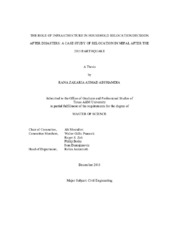| dc.description.abstract | Social resilience after disasters is characterized by two key dimensions, reducing
impacts and enhancing recovery. In that context, reducing the number of household that
are either forced or choose to relocate due to damage to their homes or infrastructure
disruption, can be considered a key resilience metric. The significance of relocation after
disasters arises from two main aftereffects. First, relocation propagates in the community;
as people leave their homes after a disaster, it becomes more likely that others will leave
as well. Second, although relocation might start as a temporary movement, it can
eventually evolve into permanent relocation. The more extensive the population
dislocating and longer the duration of that relocation can jeopardize a community’s long-term
recovery. Whilst some studies have addressed the long-term repercussions of
relocation, few focused on understanding the household relocation decision-making
process itself and the factors that influence this decision as a group. Furthermore, the
impacts of infrastructure services’ attributes before and after the disaster on the relocation
decision have not been well studied in the engineering research context. Empirical
behavior models that examine the social impacts of infrastructure resilience are critical for
proper investment in policies and measures directed to achieving infrastructure and
community resilience. This study examined the impact of three infrastructure services on
household relocation decision: piped water, government-provided electricity and vehicle-accessible
roads. Logistic regression parsimonious models of the Yes/No relocation
decision were developed using household survey data collected from Nepal after the 2015
earthquake. Different types of drivers that are expected to influence the relocation decision
were used in the development of relocation models alongside with variables capturing
aspects of infrastructure services. Examined drivers included demographic and
socioeconomic characteristics of the household and the levels of damage to homes and
neighborhoods. The consequences of infrastructure services for relocation was obtained
by controlling for these other factors and then assessing the ceteris paribus impact of
infrastructure disruption. The analysis in this study showed that the unique water service
situation in Nepal provides preliminary suggestions of the possible impacts of the pre-earthquake
redundancies and the post-earthquake resourcefulness in providing sources of
water in influencing the household relocation behavior. This unique water situation gave
rise to a new hypothesis of the effect of piped water disruption, a hypothesis that does not
necessarily conform with the general expectations in the literature. The failure and
disruption in electricity, generally provided by the government, had the highest impact on
the household’s odds of relocation among all the investigated factors. This could be a
result of the household’s sole dependency on the government for providing electricity and
the lack of backup sources of electricity in the house before the earthquake on one hand,
and the unavailability of alternative sources of electricity after the earthquake on the other
hand. Also, this study showed that vehicle-accessible roads had no significant impact on
the Nepalese household relocation behavior, which could be attributed to the low
percentage of car ownership in the community. | en |


